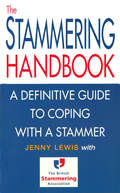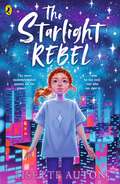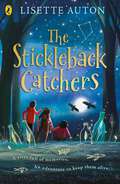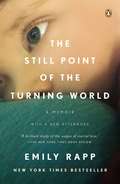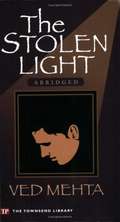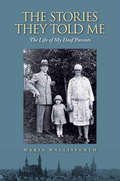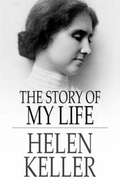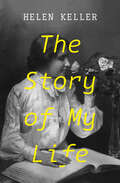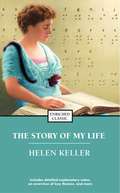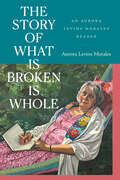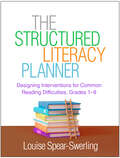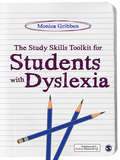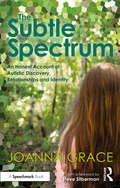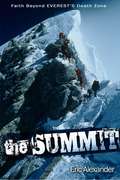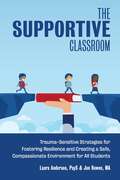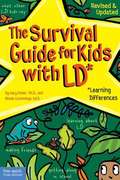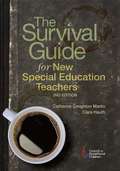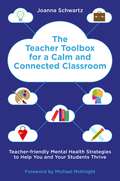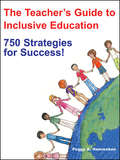- Table View
- List View
The Stammering Handbook: A Definitive Guide to Coping With a Stammer
by Jenny LewisMany people regard stammering as a joke, reinforced by the fact that they are usually portrayed on film and television as figures of fun: Michael Palin in a Fish Called Wanda, Ronnie Barker in Open All Hours. But for those who stammer - and there are half a million in Britain -the affliction is a constant source of misery and embarrassment. The Stammering Handbook aims to help stammerers of all ages cope with it in everyday life - at work, at home, at school, at play. It will be illustrated with case histories and contains advice and help for friends and relations, too. Fully endorsed by and written with the help of The British Stammering Association, THE STAMMERING HANDBOOK is essential reading.
The Starlight Rebel: Perfect for readers aged 9+, a thrilling and big-hearted sci-fi adventure set in Earth's distant future!
by Lisette AutonA sci-fi adventure full of heart - perfect for fans of Ross Welford!In the future, the most underestimated person on the planet may be the only one who can save it.The year is 3897, and life on Earth is a neon dream, all flashing lights and buzzy noise – and no one remembers that behind the illuminated shell above them there's a night sky filled with stars.As she turns 11, neurodivergent, freckled Astrifer Nova is nothing like her sporty, high-achieving twin brother, Blaze. And on the day of her Work Path Allocation ceremony which determines the course of her life, she is crushed when she gets assigned to something as boring as the sock factory.But all is not as it seems, and as she uncovers layers of hidden truths all around her, Astrifer discovers that the world is bigger than she ever imagined – and that it’s up to her and a motley crew of new friends (including one from very far away) to challenge the status quo. Turns out, their differences may be exactly what the planet needs…
The Stickleback Catchers
by Lisette Auton'A magic realist fight to save a beloved grandmother from dementia . . . dialect, disability, neurodivergence and gender-nonconformity were all woven incidentally into this open-hearted book - Guardian Best Children's Books of 2023Mimi adores her wild, fun, full-of-life gran. Then Gran starts forgetting things. Suddenly there are cracks appearing all around their home - and a mysterious black crow - both of which only Mimi seems able to see.Mimi is determined to solve the mystery. Luckily she has new friends to help: Titch and Nusrat. Together, they're the Stickleback Catchers: solvers of puzzles and seekers of adventure.Down by the river, where the gang meet and the silvery sticklebacks swim, they discover a mysterious stone, speckled with stars. But this is no ordinary stone: it's the doorway to another world, a world of talking crows and secrets, magical constellations and memories - and maybe, just maybe, Mimi's chance to bring back Gran forever...
The Still Point of the Turning World
by Emily RappTHE NEW YORK TIMES BESTSELLER With a new chapter detailing the events that have taken place since Ronan's passing in February 2013. Like all mothers, Emily Rapp had ambitious plans for her son, Ronan. He would be smart, loyal, physically fearless, level-headed but fun. He would be good at crossword puzzles like his father. He would be an avid skier like his mother. Rapp would speak to him in foreign languages and give him the best education. But all of these plans changed when Ronan was diagnosed at nine months old with Tay-Sachs disease, a rare and always-fatal degenerative disorder. Ronan was not expected to live beyond the age of three; he would be permanently stalled at a developmental level of six months. Rapp and her husband were forced to re-evaluate everything they thought they knew about raising a family. They would have to learn to live with their child in the moment; to find happiness in the midst of sorrow; to parent without a future. The Still Point of the Turning World is the story of a mother's journey through grief and beyond it. Rapp's response to her son's diagnosis was a belief that she needed to 'make my world big' - to make sense of her family's situation through art, literature, philosophy, theology and myth. Drawing on a broad range of thinkers and writers, from C. S. Lewis to Sylvia Plath, Hegel to Mary Shelley's Frankenstein, Rapp learns what wisdom there is to be gained from parenting a terminally ill child. In luminous, exquisitely moving prose, she re-examines our most fundamental assumptions about what it means to be a good parent, to be a success, and to live a meaningful life.
The Stolen Gods
by Jake PageBowdre, a powerfully built wildlife sculptor, is blind, which doesn't stop him from pursuing the truth when trouble erupts in the art world of Santa Fe.
The Stolen Light
by Ved MehtaThe author recounts his experiences as a blind college student, and tells how he came to write his first book.
The Stories They Told Me: The Life of My Deaf Parents
by Cornelia Wallisfurth Maria WallisfurthIn this heartfelt memoir, Maria Wallisfurth recounts the lives of her deaf parents in Germany from the turn of the twentieth century through the 1930s. Her mother, Maria Giefer, was born in 1897 and her father, Wilhelm Sistermann, was born in 1896. The author captures the seasonal rhythms and family life of her mother’s youth in rural Germany, a time filled as much with hardship as it is with love. When she is old enough, she moves to the nearby city of Aachen to attend a school for deaf children, where she learns to lipread and speak. After her schooling is complete, she returns home to work on the family farm and experiences the privations and fear that accompany World War I. She later goes back to Aachen, where she joins a deaf club and falls in love with Wilhelm, a painter and photographer who was raised in the city. Amidst high unemployment, food shortages, and rapid inflation, the two are married in 1925 and two years later the author is born. Under the Nazi regime, Maria and Wilhelm are ordered to undergo forced sterilization. Although their deafness is not hereditary and they submit applications of protest, they are compelled to comply with the law. Despite their dissimilar backgrounds and the political circumstances that roiled their lives, the author’s parents showed great love for each other and their only daughter. The Stories They Told Me is a richly detailed document of time and place and a rare account of deaf lives during this era.
The Story of Esther Costello
by Nicholas MonsarratEsther Costello, born on a peasant farm in Ireland, became a deaf-blind-mute after an explosion. She was discovered and saved from her predicament by Mrs. Bannister, a wealthy American. Mrs. Bannister rescued her, and brought her to Boston shortly after the 2nd World War. Mrs. Bannister taught Esther how to communicate by writing letters in her palm. Esther became an overnight success in America and around the world. Then in walks Mr. Bannister, the separated husband, but interested in how Esther can be used as a money-making machine. What happens to Esther and the Bannisters?
The Story of My Life: With Her Letters (1887-1901) And A Supplementary Account Of Her Education, Including Passages From The Reports And Letters Of Her Teacher, Anne Mansfield Sullivan, By John Albert Macy
by Helen KellerA classic of American autobiography—the remarkable story of Helen Keller&’s early life and education At nineteen months old, Helen Keller was stricken with a mysterious illness that left her deaf and blind. For the next five years, she was trapped in the silent dark, her only means of communication a few dozen rudimentary signs. Her inability to express herself was a great source of frustration, and as she grew older, Helen became prone to angry outbursts and fits of despair. Her family sought help, and in March of 1887, twenty-year-old Anne Sullivan arrived from the Perkins Institution for the Blind. One month later, teacher and student made the first of many incredible breakthroughs. By placing one of Helen&’s hands under cool running water and tracing the letters w-a-t-e-r on her other hand, Anne was able to convey the great mystery of language: that every object has a name. As Helen would later write in The Story of My Life, &“That living word awakened my soul.&” Covering the first twenty-two years of Helen Keller&’s life, from that miraculous moment at the water pump to her acceptance into Radcliffe College, The Story of My Life is one of the most beloved and inspiring autobiographies ever written. The basis for The Miracle Worker, the Tony Award–winning play and Academy Award–winning film, its heartening message has touched millions of lives and torn down countless barriers the world over. This ebook has been professionally proofread to ensure accuracy and readability on all devices.
The Story of My Life: With Her Letters And A Supplementary Account Of Her Education (Enriched Classics)
by Helen KellerEnriched Classics offer readers accessible editions of great works of literature enhanced by helpful notes and commentary. Each book includes educational tools alongside the text, enabling students and readers alike to gain a deeper and more developed understanding of the writer and their work.Left blind, deaf, and mute after an illness in infancy, Helen Keller overcame her disabilities with the help of Anne Sullivan, her inspired teacher. Her classic autobiography, first published in 1903, covers her first twenty-two years, including the memorable moment at a water pump when she first made the connection between the word "water" and the cold liquid flowing over her hand. She also discusses her friendships with Oliver Wendell Holmes and other notables, her education at Radcliffe, her joy at learning to speak, and above all, her extraordinary relationship with her teacher. This deeply moving memoir, full of love and compassion for others, offers an unforgettable portrait of one of the twentieth century's most remarkable women. Enriched Classics enhance your engagement by introducing and explaining the historical and cultural significance of the work, the author's personal history, and what impact this book had on subsequent scholarship. Each book includes discussion questions that help clarify and reinforce major themes and reading recommendations for further research. Read with confidence.
The Story of What Is Broken Is Whole: An Aurora Levins Morales Reader
by Aurora Levins MoralesThe Story of What Is Broken Is Whole collects for the first time fifty years of writing by Puerto Rican Jewish feminist and radical thinker Aurora Levins Morales. Combining well-known excerpts from her books with out-of-print and harder to find ephemeral works and unpublished pieces, this collection weaves together stories of bodies, ecologies, Indigeneity, illness, travel, sexuality, and more. As Levins Morales reflects on her use of storytelling as a tool for change, she gathers the threads of lives and places sacrificed to greed and extraction while centering care for our individual bodyminds and those of our kin, communities, and movements. This comprehensive and essential collection provides an unprecedented window into the breadth and depth of the work of one of the most significant thinkers of our time.
The Strengths-Based Guide to Supporting Autistic Children: A Positive Psychology Approach to Parenting
by Claire O'Neill'Being strength-aware has brought many moments of joy to our family life. It is this potential for growth and joy that I now want to share in this book'This flexible, dip-in-dip-out guide will introduce you to the strengths-based approach that is helping autistic children and their families to thrive. By focusing on how to identify, develop and use your child's strengths to support them throughout childhood and into adolescence, this transformative approach is here to show you and your child that their unique character-strengths can empower them and shape their future.Claire O'Neill combines her personal experience as an autistic person and mother to autistic children with her expert knowledge as a professional working with autistic young people to demonstrate the value of a strengths-based approach.With step-by-step instructions on how parents and teachers can incorporate this approach easily into family and school life, Claire also offers a variety of specific tips, tricks and engaging activities to provide ongoing support for parents and teachers alike.
The Structured Literacy Planner: Designing Interventions for Common Reading Difficulties, Grades 1-9
by Louise Spear-SwerlingStructured Literacy (SL) approaches are increasingly recognized as the gold standard for teaching struggling readers. This highly practical book walks educators through designing SL interventions for students with common types of reading difficulties--word reading, comprehension, or a combination of both. Louise Spear-Swerling offers tools for assessing students' reading profiles and tailoring SL to their needs. In a convenient large-size format, the volume is packed with case studies, sample lesson plans addressing both early and advanced stages of reading, instructional activities, and application exercises for teachers. A chapter on English language structure presents essential foundations for implementing SL effectively. The companion website features a knowledge survey about language structure (with answer key), as well as downloadable copies of the book's 14 reproducible forms. See also Louise Spear-Swerling's edited volume, Structured Literacy Interventions: Teaching Students with Reading Difficulties, Grades K–6, which surveys SL interventions across all components of literacy.
The Study Skills Toolkit for Students with Dyslexia (Sage Study Skills Ser.)
by Monica Gribben'This toolkit is the student's safety net offering user friendly, down to earth advice and real life skills that have been tried and tested by the author'-Dr John Schneider, Educational Psychologist, Edinburgh 'This is exactly how I felt starting university ... a wonderful and very helpful book full of interesting and useful hints and tips on how to survive university as a dyslexic student. It doesn't make you feel silly or stupid but makes you feel you can achieve what you set out to do'-Sharon Patterson, Adult Nursing student, Edinburgh Napier University 'You realize you're in the hands of a professional who has taught thousands of students how to succeed at university'-Holly Pellicer, Dyslexia Advisor, University of Oslo Packed with helpful advice, checklists and templates, this book will help you improve your study skills throughout your time at university. Written in a straightforward, no- nonsense style, the guidance can be broken down into manageable chunks. Issues covered include: - procrastination - planning your assignment - understanding your essay question - researching, writing and referencing your written work - managing your own well-being. Drawing on years of experience running study skills workshops in higher education, Monica Gribben has written an accessible book for students with dyslexia that shows how to work through the challenges that studying presents. The companion Website www.sagepub.co.uk/gribben has podcasts, worksheets and electronic resources to support each chapter. Monica Gribben is a private dyslexia consultant and Dyslexia Adviser at Edinburgh Napier University.
The Subtle Spectrum: An Honest Account of Autistic Discovery, Relationships and Identity
by Joanna GraceAm I autistic, or is autism something I suff er from? Should I come out, to my friends, to my family, to the people I work with? Should I drop the mask? How can I explain my experience to a neurotypical world? The Subtle Spectrum off ers an exploration into the postdiagnostic landscape of autism and the transformative journey of one woman, from her awareness of diff erence, through acceptance, to an embracing of autistic identity and beyond as she questions the cultural identity of autism. Joanna’s narrative is enriched with insights from a range of diverse contributors, creating a refl ective opportunity for people to gain a better understanding of the experience of being autistic. With a focus on relationships built across a neurodiverse divide, the book considers topics as broad as mental health, work opportunities and abuse, weaving theory and research with lived experience to give true insight into the life of an autistic person, both pre- and post- diagnosis. Written with a raw and engaging honesty, this is a crucial read for anybody who identifi es as autistic as an adult or teenager, or anyone looking to support somebody exploring diagnosis. It will also provide an invaluable insight for social workers, educators and relationships counsellors working with autistic people.
The Summer-House Loon
by Anne FineA novel about a series of extraordinary events taking place during one hot summer holiday.
The Summit
by Eric AlexanderIt's one of the greatest challenges one can face on Earth: an ascent to the top of the world on the slopes of Mount Everest. Eric Alexander experienced grace and a faith-empowering journey he will never forget as part of a record-setting team in May 2001, scaling the heights of Everest with his friend, blind climber Erik Weihenmayer. Experience some of the most dangerous locations in the world, including abject terror on Ama Dablam, a blind ski descent of Russia's Mount Elbrus, and up Kilimanjaro in Africa with four blind teens Gain wisdom in the application of trust, courage, innovation, teamwork, leadership, and integrity to overcome your own Everests. Discover practical faith lessons learned on the highest peaks of six continents. Here is the powerful story of Eric Alexander and his unique life journey of guiding people with disabilities as they overcome the most perilous places of the world. Follow in their footsteps, and learn about faith, trust, prayer, depending on God, as well as the perseverance needed in your own life. Be inspired and motivated by Eric's insight, not simply to survive but to thrive every day in God's grace.
The Sunflower Forest
by Torey L. HaydenFrom the Book Jacket: "Torey Hayden has the rare ability to write about love and hate and loyalty in ways which never fail to move the reader. I was deeply touched by The Sunflower Forest. Rabbi Harold Kushner, author of When Bad Things Happen to Good People The stunning fiction debut of a writer whose great compassion for youth and extraordinary narrative power have endeared her to readers everywhere. How do you keep it together when you're a normal, well-adjusted teenager in a family gone mad? Seventeen-year-old Lesley doesn't know. Justifiably preoccupied with high school, the prospect of college, and her first serious romance, she must also deal with a mother whose dark and tragic past in Nazi-occupied Europe drives her closer to insanity every day; with a father unwilling to acknowledge his wife's deteriorating mental state; and with a sister too young to know the difference between craziness and health. Torn between an intimate reality that is insane and the worldly pressures of her own coming of age, Lesley must muster all her strength-to stand firm in the face of the cataclysm that will soon come down on all their heads.
The Supportive Classroom: Trauma-Sensitive Strategies for Fostering Resilience and Creating a Safe, Compassionate Environment for All Students (Books For Teachers Ser.)
by Laura Anderson Jon BowenBuild a mindful, trauma-aware classroom today with this practical, easy-to-use book. Designed specifically for busy teachers, it is full of strategies and tools for understanding trauma and building empathy.One in four children have witnessed or experienced a traumatic event that can affect behavior and learning. But school can be a safe, stress-free environment that can actually reduce bad behavior, foster resilience, and heal trauma. The Supportive Classroom shows teachers and educators how they can provide the different types of trauma-aware support that each student needs. Written by two experienced school psychologists, The Supportive Classroom offers an easy-to-understand overview of trauma, empathy, and self-care paired with proactive and reactive tools that can be implemented in the classroom right away. These practical ideas include: - Suggestions for classroom setup - Proactive behavioral supports - Checklists for identifying triggers - Examples of trauma-aware support from real-life students and teachers - Strategies for recognizing trauma exposure Every teacher brings their own unique culture, style, and passion into the classroom. This book offers a blueprint for creating a safe, welcoming classroom based in trauma-sensitive practice that can be adapted to your unique classroom.
The Survival Guide for Kids with LD*: *Learning Differences
by Gary L. Fisher Rhoda CummingsThis book discusses how children with learning differences can get along better in school, set goals, and plan for the future. With references and index.
The Survival Guide for New Special Education Teachers
by Catherine Creighton Martin Clara HauthThe second edition of The Survival Guide for New Special Education Teachers is a must-have handbook for all new teachers both those in special education and those teaching in general education inclusive classrooms. The best part is the personal commentary and opportunities for reflection strategically placed throughout the guide. They make you feel like you have a mentor there to help you every step of the way.
The Tail of Max the Mindless Dog: A Children's Book on Mindfulness
by Florenza LeeAs a puppy Max’s tail is oftentimes hurt.Believing his tail to be the source of his pain, he sets out to catch and tie it in a knot. This leads to Max developing a habit of running in circles.Will Max learn a new more productive habit or will life pass him by?ABOUT THE TAIL OF MAX THE MINDLESS DOG, A CHILDREN’S BOOK ON MINDFULNESSIncorporates the Belly Breath, count of ten, and words of affirmation Adult and child are guaranteed to love this book. Mindfulness.
The Teacher Toolbox for a Calm and Connected Classroom: Teacher-Friendly Mental Health Strategies to Help You and Your Students Thrive
by Joanna SchwartzThe Teacher Toolbox for a Calm and Connected Classroom is a whole-child, whole-hearted approach to teaching, wellness, and student--teacher relationships.Chock-full of practical advice and brain-based tools from an experienced teacher and counselor, this book solves the question of how psychology and education can enrich and empower both teachers and students' wellness. Peppered with relatable anecdotes from the authors' experiences, the book deals with how to help unpack the' "invisible backpack" that both teachers and students bring into the classroom. Chapters are broken down to show how to practically address common issues such challenging behavior, social-emotional learning, trauma-informed education, attachment theory, mindfulness, mental health and much more. Each chapter outlines these common challenges but also provides an abundance of practical tools that can be used to help. Written accessibly, and with tools which are easy to implement, The Teacher Toolbox for a Calm and Connected Classroom is an indispensable guide for any teacher.
The Teacher's Guide to Inclusive Education: 750 Strategies for Success!
by Peggy A. HammekenThe ‘nuts and bolts’ of supporting an inclusive program or implementing a new one! Helping teachers meet all students’ learning needs in today’s diverse classrooms, this comprehensive resource shows how to establish an inclusive education program or enrich an existing one. The author provides strategies to assist students who are in special programs, who may be at risk, or who simply need additional support to be successful. Offering 108 reproducible forms and a complete resources section, this practical guide covers: Reading and written language accommodations Strategies for daily assignments and assessments Teaching strategies for mathematics Approaches for improving student behavior
